This review was originally published on ZeldaChronicles (formerly known as ZeldaEurope) and got translated for this blog in 2022 by the same author.
After the excellent remake of Ocarina of Time 3D, fans were hoping that Majora's Mask were to get the same treatment for a long time. It's certainly a fan favorite title with its dark atmosphere, its rich game world, and its crazy collection of masks, where all the support for a remake shouldn't be surprising at all. Almost four years later, in February 2015, it then finally happened and Majora's Mask 3D was released alongside the New Nintendo 3DS. But did it live up to the quality of Ocarina of Time 3D? Is it really the ultimate version of the game? Let's find out!
This review will mainly focus on the qualities of the remake, compared to original N64 game and Ocarina of Time 3D. Technically, this could be viewed as only a "remaster", but nonetheless the term "remake" will be used throughout the review. Most of the screenshots in this review were taken from Miiverse.
Three Days, 24 Masks
Let's start with an introduction, which you can skip if you're already familiar with the original game. Majora's Mask is celebrating its 15th Anniversary this year and even after all these years it's one of the darkest and most bizarre episodes in the Zelda series, where this is without a doubt a fan favorite for many.
From the moment Skull Kid takes you into the parallel world of Termina, where many familiar faces from Ocarina of Time appear in new roles, you enter a lively and rich environment, whose fascinating atmosphere will capture your imagination. The heart of it all is Clock Town with its inhabitants, who all have their daily routines, which you can observe and even alter.
Always above you is the impending danger of the moon, threatening to destroy everything in three days. But thanks to the Song of Time you can go back to the beginning of the three days and relive them. While the limit of three days (which are about 54 minutes in real time) may be daunting for some, this actually isn't a game where you truly have to play against time, it's a game where you play with time. Travel back, travel forth, see what changes. The Inverted Song of Time also lets you slow down the flow of time, which takes a away a lot of the pressure. And if you give the whole thing a chance, then Clock Town will turn into a playground of time, where you can affect the lives of the people and try different things with each cycle. It's the Groundhog Day of the Zelda series and it's a very rare and exciting concept for a video game.
If you leave the walls of Clock Town, which are found at the very center of Termina, then you will enter one of the most fascinating overworlds the Zelda series has to offer. While other 3D Zelda games usually had some issues with wide and empty plains, Termina Field has something to discover in every corner. And in every cardinal direction an impressive area is waiting for you, where you get in contact with the other tribes: the Dekus in the Southern Swamp, the Gorons in the snowy mountains to the north, the Zora at the Great Bay in the west, and the undead of Ikana to the east.
Via masks you also have the opportunity to become a part of these tribes. Next to the three day cycle, this is the second big feature of Majora's Mask: with a total of 24 masks you can obtain special abilities and even transform into different beings. As a Deku you hop over water and fly over abysses, as a Goron you roll through the environment and smash things with your fists, while as a Zora you can dive deep into waters and use your fins as a boomerang. This also puts you into the role of certain deceased characters, which lets you interact with the characters in completely different ways. And this is again a very unique experience, one that some may even have missed in later Zelda games.
Other than some mini-dungeons, only four major temples await you in Majora's Mask, which is notably less than in other Zelda titles. But the temples are all really well made and the journeys to them offer some of the most complex quests in the Zelda series, where you will experience a lot.
And the real focus of the game lies on the sidequests, where you explore the world, alter the fate of the people in Termina, or master the many minigames. Other than the 24 masks, there are 52 Pieces of Hearts to collect, where Majora's Mask is currently still the record holder. Each temple also has 15 Stray Fairies to find, which is yet another unique thing in the series. And in a similar fashion, there are two Spider Houses, where you can hunt for Gold Skulltulas.
You also have more in-depth ways of interacting than in other Zelda games. Especially Anju's search for Kafei is one of the most complex sidequest in the history of the Zelda series. And thanks to all these sidequests Majora's Mask has about the same amount of content as Ocarina of Time, despite the smaller number of dungeons.
You really want to give this game a try if you haven't already. And whether you should be doing that via the Nintendo 64 original (which is available on the Wii and Wii U Virtual Console for cheap) or the new version for the Nintendo 3DS is something that this review may tell you.
Graphics & Sound
Ocarina of Time 3D was one of the first major titles for the Nintendo 3DS and amazed with its new visuals for the Nintendo 64 classic, which let you re-experience the game and discover new details everywhere. Majora's Mask 3D is on par with the visual quality of the previous remake, but it doesn't deliver the same "wow effect". And one reason for this may be the fact that Majora's Mask on the Nintendo 64 already had better graphics than Ocarina of Time thanks to the Expansion Pack, where it was one of the best looking game for the system, if not the best looking. So, Majora's Mask 3D looks a lot more how you are remembering it and you really have to compare both versions to see all the differences.
GREZZO still managed to put new details into most places, like posters all around Clock Town, some new Easter eggs, and even a miniature model of Clock Town in the mayor's office. Fans of the original game surely will take their time to look around and discover all the new details.
For the most part GREZZO also did a good job with the re-modelling of the environment, enemies, and characters, some more than others. Most of the character models got completely overhauled and now look a lot more like their artworks, though some characters and enemies got only touched up slightly.
One visual issue in Ocarina of Time were flat 2D objects, like fences, which got ported over from the Nintnedo 64 original and look really weird on the Nintendo 3DS and its 3D effect. While grass and foliage still get rendered as flat textures in Termina, this doesn't stand out as much and for the most part everything got proper models now. Only the plots of soft soils on walls stick out, quite literally, because they were not properly aligned, offering an odd sight.
And one major flaw still returned from the previous remake: the stairs. Like on the Nintendo 64, they are only textures on a slope, which just looks bad. You would think that modeling and rendering a proper staircase wouldn't be a big deal today. And this is somewhat embarrassing, especially since there are so many stairs in and around Clock Town, where this ultimately attracts attention.
Just like Ocarina of Time 3D, the game is more brighter than the original, which you will mainly notice inside the dungeons. But the Great Bay Temple actually profits from this and the brighter visuals are generally better for a handheld game, where you might want to play outside, and they are also better for the 3D-effect to avoid ghosting.
The 3D effect itself, however, took a step down from the quality of Ocarina of Time 3D. It doesn't have the same depth and the camera is closer to Link, where you sometimes even get clipping errors that can be very unpleasant with the 3D turned on and can also obscure your view. It's especially noticeable with the new fishing minigame, where the camera sometimes goes inside the fish. Ocarina of Time 3D didn't have as many issues, simply because the camera and field of view were better.
Also, while the frame rate overall runs at a much nicer 30 frames per second (as opposed to the 20fps of the original Nintendo 64 version), it occasionally drops, especially when there are multiple particle effects going on. This is a problem from the original game and seems to be a general issue with the Zelda remakes and remasters, since both Ocarina of Time 3D and The Wind Waker HD also had similar frame drops. Using a New Nintendo 3DS over a normal Nintendo 3DS also makes no difference here.
And don't expect much from the sound department, because the music and sound effects from the original game simply return in slightly better quality. There are some changes with ambient sounds, e.g. you can't hear the carpenters hammering in every part of the town at all times. The Kakariko Village music from Ocarina of Time 3D also returns for the fishing ponds and there's a new music piece for the extended credits. But that's pretty much it and that's okay, since both the music and the sound background were a huge part of the original game's fantastic atmosphere and hold up very well even today. You're still getting those goose bumps from experiencing Clock Town day and night, despite or even due to the absent hammering.
Controls & Interface
The interface of Ocarina of Time 3D had some flaws, which luckily got taken care of in Majora's Mask 3D. One of these concerned the map, where its usage in Ocarina of Time 3D was rather pointless. The touchscreen had the useless overview map, while the HUD on the 3D screen showed you a small map in the bottom left corner, like on the Nintendo 64, which was too small there to be useful and only made you see less.
That's already a lot better in Majora's Mask 3D, where the map fully uses the touchscreen, shows your current position, moves alongside you, and shows some helpful details. For example, the places where you've already found Stray Fairies are marked on the dungeon map. The 3D screen stays free of the map, even though the lower border still gets used for the clock. Eventually, this should have moved to the touchscreen as well, but at least the clock is actually useful.
The item menu also has improved since Ocarina of Time 3D, where it now works like in A Link Between Worlds. This means you can arrange your items and masks in any way you want and then assign them to buttons. In Ocarina of Time 3D the menu was more like in Link's Awakening, where your items were taken out of the inventory into the button slots, which made it difficult to sort them properly.
The Magic Arrows got split into individual items again, where now you even can equip them all at once, like having Fire Arrows on X and Ice Arrows on Y. That's still not as simple as in The Wind Waker, but far better than the inconvenient arrow menu in Ocarina of Time 3D.
Only assigning the touch buttons (I and II) in the right corners of the touchscreen doesn't work as nicely as before, because you now have to drag the items over the screen, instead of simply tapping the corners. Your Pictograph Box and Ocarina of Time also are now always found in the left corners of the touchscreen, so that they don't take an item slot and you don't have to equip them manually all the time. The different musical instrument of Link's masks even got their own icons now, which replace the Ocarina of Time whenever you're transformed. (Those actually existed in the code of the original game, but were never used there.)
One of the biggest improvements comes again with the gyro aiming, like in Ocarina of Time 3D and The Wind Waker HD before. Scoring a "Perfect!" in the shooting galleries was never as easy as it is now. These minigames were really hard to master with the analogue stick, especially on the Virtual Console, where the sensitivity was messed up, but here you can do it first try. Still, if you prefer to use the Circle Pad, then you can do so or use a mix of both.
There are even some options now, where for example you can invert the camera controls for different actions. If you own a New Nintendo 3DS or a Circle Pad Pro, then you can also move around the camera with the C-stick. But it feels somewhat stiff and slow compared to the same feature in The Wind Waker, where you might not use it as much.
When you're flying around as Deku Link, you can also use the R-button to view downwards, which now lets you time your landing perfectly. As a Goron you also don't have to hold the A-button any longer, which feels odd at first, but is certainly more comfortable during longer races. At the same time you have to hold two buttons at once for the faster swimming as a Zora, but we'll get to this later...
Time Travel & Saving
Nintendo and GREZZO's goal was to optimize Majora's Mask 3D wherever they could to make it more accessible. You expect that this actually leads to teaching you the hidden songs for manipulating time right away, but that doesn't happen, even though the Inverted Song of Time is still your most important tool for time management. Curiously, they have even nerfed the song, where it now only slows down the flow time to half, instead of a third.
In the Nintendo 64 version it was thanks to the Inverted Song of Time that you rarely ever had any real time pressure. In the remake you have to be more thoughtful about what you're trying to achieve within one cycle and you won't be able to achieve the same amount of things as before. While the halved tempo feels quite right, there really should have been an option for how much you want to slow things down. And this change is certainly won't things more accessible to new players.
The Song of Double Time on the other hand got pretty much perfected and should a blessing to new players and Majora's Mask veterans alike. Now you can choose the exact time to where you want to jump to. And this eliminates all waiting times, as long as you know when the important things are going to happen. This is especially helpful during the Anju and Kafei quest, where this plays out a lot faster and more fluidly, because you don't have to stand there and wait for certain events to happen. You simply skip forward to the right time and go on.
Thanks to the new saving system you also can't do much wrong. You can now only save at the Owl Statues, but unlike in the N64 original they will create a permanent savestate. This can be used to save right before some critical events, where you may screw something up, e.g. the puzzle in Sakon's Hideout. And this saves you from some unnecessary frustrations.
The Song of Time itself now won't save the game any longer, but this also takes away its finality. In the original game you really had to be certain about going back in time, because you couldn't just load your last savegame in case you've forgotten something important, like bringing all your collected Stray Fairies to the nearby Fairy Fountain.
Clock Town also has seen some renovations to make saving and traveling back in time more convenient. There is now a new square behind the Clock Tower, where you can find both the Owl Statue and the bank, so you can quickly save your game and manage your savings before and after a jump back in time. This place quickly turns into your primary entry point, because it's just so central and convenient, where you can really get used to this change.
In addition, you can now find so called Quill Statues in certain places, which can be used to save your game, but not as a teleportation point. Those are usually found at the entrance of dungeons and some other important places, like the Deku Palace. Some of them probably could have been turned into Owl Statues as well, while there also should have been some additional Quill Statues here and there, most importantly at the new fishing ponds.
New Guidance
The Bomber's Notebook has been fully revamped, which you now get directly from the Happy Mask Salesman, so that you won't miss it by any chance. The original version had a clear timetable for 20 select characters, but by now the notebook covers all sorts of sidequests where you get something from someone.
The events in their schedules, which tell you when important things are going to happen for a character, now only get revealed once you've experienced them once yourself and not upfront. This way the Bomber's Notebook might actually be less helpful than it used to be, but it's with all certainty more annoying, because it keeps showing up after interactions only to tell you what you've just been told a second time.
These entries can also be satisfying, however, and the new version of the Bomber's Notebook feels more like a checklist, which tells you what you've already achieved in the game. The Bombers will also give you hints about sidequests that you have missed so far, where they are much more useful now. In that case they will run towards you, which looks quite funny.
It even keeps track of sidequests that only give you Rupees. For example, there is now an incentive to play the lottery or help certain Zora, which you may have completely ignored in the N64 version. This adds a better feeling of completion, where the Bomber's Notebook essentially serves as a 100% checklist, covering all the masks and the majority of Pieces of Heart.
The rest of the Heart Pieces can be tracked via the Sheikah Stone inside the Clock Tower, which lets you view visions. Those are little videos to give hints about pretty much everything in the game, just like in Ocarina of Time 3D and Skyward Sword. And this complements the Bomber's Notebook quite well. However, it's probably not something that gets used by many players, because the fact that you have to return to the Clock Tower to use it makes it much less convenient than quickly checking the internet for help.
But at least the Bomber's Notebook and the Sheikah Stone combined will give you a complete checklist of all 52 Pieces of Hearts, which is especially useful when you're missing a few, but don't really know which ones you already got. In that case even a guide on the internet could not help you as much.
You can also set alarms inside the notebook for specific times, where Tatl then will remind you that you wanted to do something without giving you any specifics. Still, that's a good way to make sure that you don't forget important events, but you will have to remove the alarms manually afterwards, which feels a bit inconvenient.
New Old Bosses
Odolwa, Goht, Gyorg, Twinmold – the four bosses of the temples from the original Majora's Mask sure were something special. They were quite open boss fights, which didn't employ the typical weak point system and instead give you multiple methods of attacking them. Despite the fact that this is actually quite refreshing, Nintendo seemingly didn't like that and turned all the bosses upside down, so that only one method now works well and the fights follow a clear procedure. Every boss now has a giant eye as its weak point, which looks like the eyes from Majora's Mask and took over these beings like a parasite, which is certainly creepy.
Odolwa now blocks most of your ranged attacks, much more than he did before, where he is not as easy to defeat and you will need to make use of Deku Link. In return he's slightly slower now. Goht is the one boss who has changed the least, but there are some new obstacles showing up when you chase him. And when the giant eye pops out of his body, you will have to change forms to attack it with arrows. This seems forced, but at least the Fire Arrows have a cool effect in this.
While Odolwa and Goht still feel quite close to their originals, Gyorg and Twinmold got changed completely. Both battles have two phases in the remake and can also drag on for a while. In Gyorg's first phase you're now rather compelled to fight him from the platform, but he will destroy it for the second phase, so you will have to use Zora Link and play a game with mines, which can depend on random factors and cost a lot of time.
Twinmold is even worse. In the first phase you have to fight one of the worms with arrows, while the other bombards you. Only after defeating the first worm you will get the Mask of Giants, which now turns you into a gigantic wrestler for some reason. And the new version of this battle of giants doesn't play very well, because Link gets knocked down by every touch of the second worm and the battle completely overstays its welcome. You also can't use your sword any longer, which takes any advantage from having a stronger one. The original version of this battle may have been simpler and not as imposing, but felt more wholesome overall.
Better or Worse
The bosses aren't the only thing that has changed, where Majora's Mask 3D has seen way more modifications than the previous remakes and remasters did. Mainly, things have been repositioned in many places and the locations of some items got swapped or altered, so that they are more accessible.
For example, you will now learn the Song of Soaring right at the entrance of the Southern Swamp. The Fairy Fountain in Woodfall is now closer to the exit and will reward you with the doubled Magic Meter, which is very useful for the Snowhead Temple afterwards. One Bottle can be gotten much earlier than before, but this removes the one on Ikana Graveyard, so that there are only Pieces of Heart to find there after the first day, which is a bit boring. The Stone Mask is now also hidden in a completely different place, where the opinions are certainly divided about this.
Some of the Stray Fairies inside the temples are easier to find, which seems a tad unnecessary and also destroyed some good hiding spots, but at least this is limited to the early game. The temples themselves have seen some adjustments in addition, where for example the Stone Tower Temple has now the red emblem above its entrance. That's a very convenient change, because you don't have to move the blocks out of the way any longer in order to shoot at it.
The most controversial change is probably the Zora swimming. Now, Zora Link swims rather slowly by default, which feels very similar to using the Zora Armor in Twilight Princess. And this can actually be quite useful for the narrower underwater passages, e.g. inside the Pirates' Fortress, where this change makes sense. However, as a result, the faster swimming was now combined with the barrier, which consumes your Magic. So, you can't just swim around freely all the time, like you could on the Nintendo 64. And having the barrier in front of your view all the time is quite annoying in 3D and can also lead to frame drops.
Plus, the game world wasn't properly adjusted for this. While the Goron roll also uses up your Magic, there are many ways to refill it while rolling through the environments. The only place where they thought of adding some Magic Jars underwater was the Beaver Race, which plays even worse than it did originally thanks to the barrier and the altered controls. But everywhere else in Great Bay you may simply run out of magic. While this makes the Green Potion much more useful, only a Chateau Romani can now give you the swimming experience from the original Majora's Mask. And this feels like such a bad solution overall, where there could have been other ways of implementing the two different swimming speeds, like pressing the A-button twice.
The Ice Arrows also got changed to the worse, where now they can only be used at preset points, which are sparkling on the water. Only inside Gyorg's chamber you can use the Ice Arrows freely to make ice floes anywhere you want, but that's not so useful there. The Ice Arrows were one of the most impressive features of the N64 original and have never returned with such an ability so far in the series. So, that this got taken away is very disappointing.
And it also doesn't make it any easier to use the Ice Arrows, because you need to hit the points of sparkling water, where you may miss them. It seems like Nintendo / GREZZO mainly wanted to avoid some glitches and shortcuts that were possible with them. But they should have fixed those, instead of limiting the freedom of the players even further.
They've also removed the initial speed boost of Deku Link's spins, but otherwise this transformation has actually seen some improvements. The bubbles are stronger now, because they fly farther and hit a larger area. You even get reticle for aiming now. However, you can now only shoot them when they are fully charged. And in addition to the improved camera while flying, which lets you view downwards, some of the flight passages have been made easier, because the platforms now only starting moving once you've landed on them. This may save you some frustrations, but it also removes most of the challenge in these cases.
Another noteworthy change comes with the Garo's Mask, which now looks like a Garo Master. Both variants look good, but the new version is a better fit for the dialogues, since the normal Garo will confuse you for one of their masters. And the Mask of Truth now got the functionality of the Stone / Shard of Agony, where it shows you any hidden grottos. Curiously, there is no mention of this new feature anywhere in the game.
Fishing with Masks
After analyzing in detail what got changed, let's talk about what's really new. And Majora's Mask 3D is the first remake / remaster of a 3D Zelda game that comes with new places to explore: the Swamp Fishing Hole and the Ocean Fishing Hole. Both of these places were nicely integrated into the existing environments, look very pretty, and invite you to catch a total of 24 different fish – 12 per location.
Fishing is a traditional minigame in the Zelda series, which was part of Link's Awakening, Ocarina of Time, Twilight Princess, and Phantom Hourglass. Elements from all of these versions were taken into Majora's Mask 3D to create the most complex Zelda fishing minigame as of yet.
The Fishing Pond from Ocarina of Time served as a prototype, but feels like a bad demo in comparison. The Sinking Lure is now a legal tool, and you can switch between it and the regular lure to target fish in the depth or near the surface. Fishing is also a little easier than in Ocarina of Time, as fish don't break free from the line so quickly.
To make things a little more interesting, both the time system and your masks play an important role here. Some fish can only be found during certain times. Some fish only appear after certain events. And some fish can only be baited with certain masks. This gives some of the masks additional usage in the game, which is great for the ones that didn't see much love before, e.g. the Postman's Hat.
A lot comes together here and you can make it your goal to collect every type of fish at least once, where completing your collection can take several hours. Tatl keeps track of your catches and you can view the statistics via a board next to the entrance.
The only problem is that it depends entirely on chance whether certain fish will appear or not. As a result, you will have to leave and re-enter the fishing hole repeatedly until the fish you're looking for finally appears. And this could have been avoided by a deterministic system, where the same fish will appear at the same time and the same conditions. Partly this is even the case, it's just that the RNG was added on top and can be really annoying.
In addition, the given lengths of the fish don't always match what you have in front of you and are also completely different between the language versions, which is odd. And going for records is all there is, by the way, since there is no reward for the fishing and it also doesn't get an entry in the Bomber's Notebook. This means that this is a completely isolated sidequest, truly a game within the game, which you can safely ignore if you don't enjoy it.
Other Additions?
Majora's Mask 3D has been in development since 2011. This is three times as long as the original Nintendo 64 title, which got created within a year. If you hear that, then this will raise the expectations for what could have been improved and you will see potential for additions everywhere. Sadly, Majora's Mask 3D only adds to the long list of missed opportunities.
Besides the new fishing holes, the 3DS version only offers one additional Bottle to find, which wasn't there in the original. And this mainly to fill a gap in the item menu, something that should have already been done in Ocarina of Time 3D. A new sidequest got added for this, where a mask gets utilized, which wasn't very useful originally. You might even say that it was the most useless mask, where it's nice that it has a slightly bigger role now. And a new type of milk gets introduced with this as well.
Otherwise there isn't anything new to be found in Termina. There is no new minidungeons, where a third Spider House could have been awesome. There are also no new masks, no Master Quest mode, nor a Hero Mode.
Since Majora's Mask focused more on the sidequests and there is no imminent replay value, it's understandable that Nintendo didn't want to add a simple Hero Mode, like in Skyward Sword or A Link Between Worlds. Either you are still busy with the many sidequests or you will feel like you are done with the game for now. And you can replay the dungeons at any time any, where this can be even more fun than replaying the entire game from the beginning.
However, the Hero Mode could have been an option that's available right from start, similar to how it was done in The Wind Waker HD, to offer a little more of a challenge. And for fans it would have been truly exciting if there were something like Master Quest, where you would think that this should be in the realm of possibility after more than three years of development.
They also could have done something more with the Picto Box. While it's now always accessible via the touchscreen and takes photos in color, it still gets used for the same old purposes and still can only save one picture at a time. That's really disappointing, because this item was improved in some many fun ways in The Wind Waker HD. You were able to make funny selfies and it also gave you a sublime connection to Miiverse, which is still unmatched today. So, it's a shame that it didn't get some more attention in Majora's Mask 3D, despite all the potential.
At the same time you have to praise Nintendo and GREZZO that they didn't force any new modern features into this, like StreetPass, which wouldn't have been a good fit for this title. They could have used different amiibo to add more masks, like the Super Mario mask for example, but luckily they didn't and Majora's Mask 3D is still a completely normal game, without content locked behind any shenanigans.
Conclusion
The goal of remakes and remasters should always be to create the ultimate version of a game, which improves upon everything and makes the original obsolete. But with Majora's Mask 3D Nintendo hasn't met this goal. Some things were made easier, others more difficult. Some things got improved, others got worse. And some things are just different now.
In any case, it's still the better version for beginners. The Nintendo 3DS version has prettier graphics, runs more smoothly, and also offers a much more convenient time and save system, where it's just the better experience overall. Fans of the original on the other hand will be confronted by some questionable changes, where the improved visuals and the new fishing holes probably won't make up for it.
The Good:
- Portable version of a classic
- Extensive fishing expansion
- Nicer graphics with many new details
- Improved time travel and saving
- Good usage of maps
- Sortable item menu
- Useful check list with the Bomber's Notebook
- Precise aiming with gyro
- More usage for various masks
- Lots of optimizations
The Bad:
- Some disimprovements (swimming, Ice Arrows, ...)
- Questionable changes of the boss fights
- 3D clipping errors
- Some dips in the frame rate
- Small graphical flaws
- No Hero Mode or Master Quest


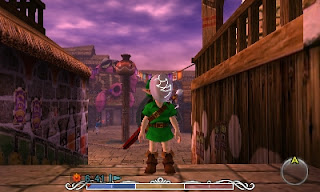

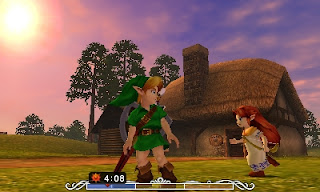
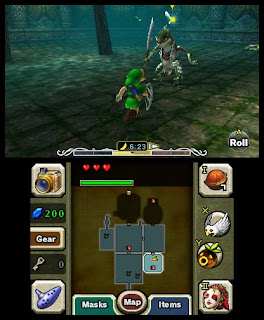
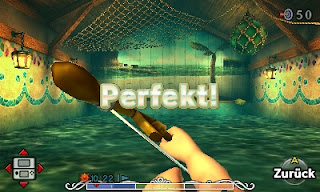

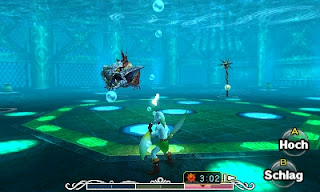
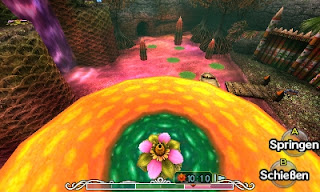


No comments:
Post a Comment